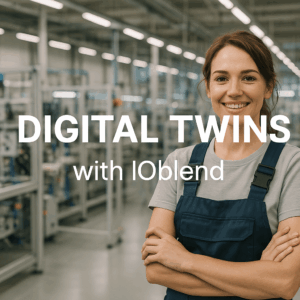Real-time Data Integration
IOblend:
- Supports real-time, production-grade data pipelines using Apache Spark with proprietary tech enhancements.
- Can integrate equally streaming (transactional event) and batch data due to its Kappa architecture.
Talend:
- Offers real-time data integration features but relies on a combination of batch and real-time processing.
Low-code/No-code Development
IOblend:
- Provides low-code/no-code development, accelerating data migration and reducing manual data wrangling.
Talend:
- Features a drag-and-drop designer for designing data integration and ETL processes but might require more configuration and scripting for certain complex tasks.
Data Architecture:
IOblend:
- Enables delivery of both centralized and federated data architectures.
Talend:
- Primarily based on a centralized data architecture, although it can support federated designs with appropriate configurations.
Performance & Scalability:
IOblend:
- Boasts low-latency, massively parallelized data processing with speeds exceeding 10 million transactions per second.
Talend:
- Provides scalable data integration solutions, but performance can vary based on the underlying infrastructure and configuration.
Partnerships & Cloud Integration:
IOblend:
- Has real-time integration capabilities with Snowflake, AWS, Google Cloud and Azure products and is an ISV technology partner with Snowflake and Microsoft.
Talend:
- Offers cloud integration with various platforms including AWS, Google Cloud, Azure, and Snowflake, among others.
User Interface & Design:
IOblend:
- Comprises of two functional parts: IOblend Designer and IOblend Engine.
- IOblend Designer is for designing, building, and testing data pipeline DAGs.
- IOblend Engine performs the calculations and can be flexibly deployed on-prem, cloud or dev machines via containers
Talend:
- Provides a unified studio for designing and executing data integration jobs.
Data Management & Governance:
IOblend:
- Manages data throughout its journey with features like record-level lineage, CDC, metadata, schema, de-duping, cataloguing, etc.
- All as part of each data pipeline automatically (flexible configurations). No need to purchase additional modules.
Talend:
- Also offers robust data governance and data quality tools, but the features may differ in implementation and granularity.
Cost & Licensing:
IOblend:
- The Developer Edition is free, whereas the Enterprise Suite requires a paid annual license.
Talend:
- Provides a free community version (Talend Open Studio) and has premium versions that come at a cost.
Deployment & Flexibility:
IOblend:
- Can operate on any cloud, on-prem, and hybrid environment.
- Comes in two flavours: Developer Edition and Enterprise Edition.
Talend:
- Flexible deployment options across cloud and on-prem environments.
Community & Support:
IOblend:
- As a relatively new solution, the community is still small. Developer Edition support is online. Enterprise Edition receive premium support.
Talend:
- Has a large community (Talend Open Studio) and offers premium support for its enterprise users.
In conclusion, IOblend focuses on real-time data integration with low-code/no-code solutions using Apache Spark and is tailored for more modern data needs, especially in operational analytics.
On the other hand, Talend, being a more established player, offers a wide range of features suitable for various integration scenarios. The choice between the two will depend on the specific needs, infrastructure, and preferences of the enterprise.

ERP Cloud Migration With Live Data Sync
Seamless Core System Migration: The Move of Large-Scale Banking and Insurance ERP Data to a Modern Cloud Architecture ⛅ Did you know that core system migrations in large financial institutions, which typically rely on manual data mapping and validation, often require parallel runs lasting over 18 months? The Core Challenge The migration of multi-terabyte ERP and

Legacy ERP Integration to Modern Data Fabric
Warehouse Automation Efficiency: Migrating and Integrating Legacy ERP Data into a Modern Big Data Ecosystem 📦 Did you know? Analysts estimate that warehouses leveraging robust, real-time data integration see inventory accuracy improvements of up to 99%. The Convergence of WMS and Big Data Data professionals in logistics face a profound challenge extracting mission-critical operational data such

Dynamic Pricing with Agentic AI
The Agentic Edge: Real-Time Dynamic Pricing through AI-Driven Cloud Data Integration 📊 Did You Know? The most sophisticated dynamic pricing systems can process and react to market signals in under 100 milliseconds. The Evolution of Value Optimisation Dynamic Pricing and Revenue Management (DPRM) is a complex computational science. At its core, DPRM aims to sell the right

Smarter Quality Control with Cloud + IOblend
Quality Control Reimagined: Cloud, the Fusion of Legacy Data and Vision AI 🏭 Did You Know? Over 80% of manufacturing and quality data is considered ‘dark’ inaccessible or siloed within legacy on-premises systems, dramatically hindering the deployment of real-time, predictive Quality Control (QC) systems like Vision AI. Quality Control Reimagined The core concept of modern quality

Predictive Aircraft Maintenance with Agentic AI
Predictive Aircraft Maintenance: Consolidating Data from Engine Sensors and MRO Systems 🛫 Did you know that leveraging Big Data analytics for predictive aircraft maintenance can reduce unscheduled aircraft downtime by up to 30% Predictive Maintenance: The Core Concept Predictive Maintenance (PdM) in aviation is the strategic shift from a time-based or reactive approach to an ‘as-needed’ model,

Digital Twin Evolution: Big Data & AI with
The Industrial Renaissance: How Agentic AI and Big Data Power the Self-Optimising Digital Twin 🏭 Did You Know? A fully realised industrial Digital Twin, underpinned by real-time data, has been proven to reduce unplanned production downtime by up to 20%. The Digital Twin Evolution The Digital Twin is a sophisticated, living, virtual counterpart of a physical production system. It
